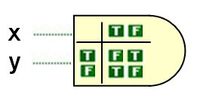-
Analysis & Computation
305 -
Development & API
2 -
Development Tools
1 -
Execution & Performance
1,027 -
Feed management
1 -
HW Connectivity
115 -
Installation & Upgrade
267 -
Networking Communications
183 -
Package creation
1 -
Package distribution
1 -
Third party integration & APIs
289 -
UI & Usability
5,456 -
VeriStand
1
- New 3,057
- Under Consideration 4
- In Development 4
- In Beta 0
- Declined 2,640
- Duplicate 714
- Completed 336
- Already Implemented 114
- Archived 0
- Subscribe to RSS Feed
- Mark as New
- Mark as Read
- Bookmark
- Subscribe
- Printer Friendly Page
- Report to a Moderator
General Comparison Operator (as an Express VI?)
I rarely use boolean operators to solve logical problems. Instead, as I would suppose the majority of users, I use them to respond to a set of conditions and perform actions in response to different cases.
The current set of operators:
is, to say the least, quite difficult to use. For instance, for the third operator, the help window provides the following explanation:
Now if you invert one of the inputs, good luck to figure out at first glance, when you revisit your diagram, what the outcome of the comparison will be.
In fact, what we need is some kind of matrix operator for which we type in the output of the comparison of A (input 1) and B (input 2) for the different cases:
Here I have supposed the inputs are "modified-booleans" with an "undefined" case, and the output of the comparison is an integer value, just to illustrate that operators for non-booleans could be treated the same way.
In the strict boolean operator case, there would be no "U: case and the output would be T or F. It would be a simple matter (I guess) to let the boolean operator icon show the outcome of the comparison in a way similar to something like that:
In general I find useful to have non-boolean outputs (as in the matrix above where integers were used) to be able to handle complex situations. Of course the icon would have to reflect the values selected by the user...
Which brings the issue of the configuration of this operator. Considering that the interface for this operator would be quite sophisticated, it would make sense to provide it as one of the Express VIs (such as the "Formula" or "Comparison" functions).
You must be a registered user to add a comment. If you've already registered, sign in. Otherwise, register and sign in.




